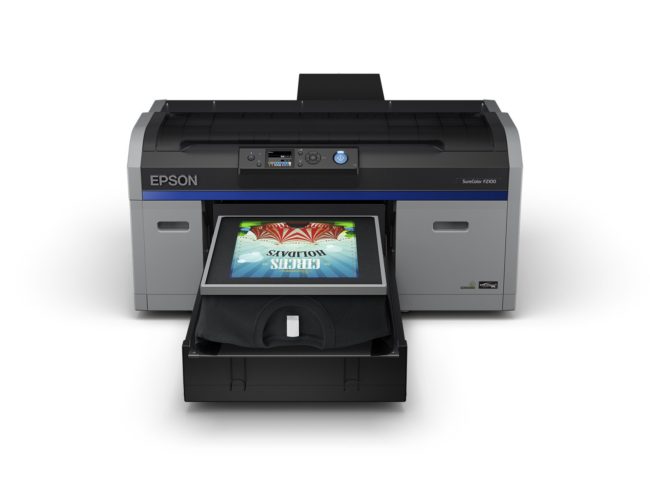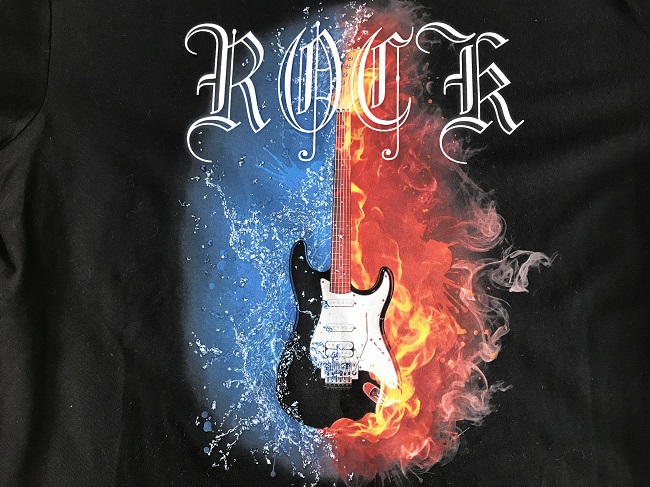At the ISS Decorated Apparel Expo and Conference in Long Beach, California, Epson announced a successor to their popular SureColor F2000 direct-to-garment (DTG) printer — the new SureColor®F2100. Designed to improve reliability, performance, and print quality, the SC-F2100 can help garment decorators increase their efficiency on short-run orders and enable print shops and design studios expand their service offerings.

The SC-F200 can be equipped with different types and sizes of platens to print directly onto cotton and poly/cotton garments and accessories, including T-shirts, hoodies, jackets, and tote bags.
Background
The first DTG printers were built by enterprising engineers who adapted inkjet printing technology originally designed to print photos and graphics. Some of these models were used repurposed Epson printheads. But they often didn’t perform as well as expected. Those printheads weren’t really designed for use with the textile ink chemistries required to print T-shirts that remain soft, comfortable, and machine-washable.
So, when Epson introduced their own purpose-built, commercial-grade SureColor F2000 DTG printer in late 2013, the printer was an immediate hit. The Epson printheads, inks, hardware, and software were all designed by Epson to ensure consistent, reliable printing on garments.
Screen printing companies that produce high volumes of decorated garments use the F2000 for short-run orders and on-demand printing of custom T-shirt orders from e-commerce sites. It is also used by designers who want to start a T-shirt printing business on the side and art stores that want to enable customers to convert popular wall-art designs into wearable art.
“The SureColor F2000 is the number-one selling direct-to-garment printer in the market and has helped customers increase efficiency on short-run orders and expand service offerings,” said Tim Check, senior product manager, Professional Imaging, Epson America. “We listened to our customers and addressed common direct-to-garment pain points with the new SureColor 2100.”
The SC-F2100 delivers requires less maintenance by users and provides increased speed and efficiency.
The SC-F2100 printer features the Epson PrecisionCore TFP printhead, UltraChrome DG garment ink technology, robust hardware, an integrated self-cleaning system, and new print modes that can achieve up to twice the printing speeds of the F2000.
Unlike the SC-F2000 (which could be purchased either as a CMYK printer or CMYK + White ink printer), the SC-F2100 will be sold only as CMYK + White configuration.
Reliability
Many buyers of DTG printers expect to be able to use their printers for several years beyond the three-year period for which extended warranties are available. In order to do, the printer must be properly maintained to prevent build-ups in the ink lines or clogs in the printhead.
The white inks used as a base layer for accurate color printing on dark garments can be tricky to work with. The pigment particles are heavy and can clump together, causing blockages in the ink tubes and print nozzles.
The inline cleaning system on the F2100 automatically transports cleaning fluid through a channel in the printhead and the ink lines to dissolve ink build-up. This eliminates the need for the printer operator to perform a five-minute ink-tube flush at the end of each workday. According to Check, the cleaning cycle doesn’t use any ink and cleaning cartridges designed to last two or three months will cost around $20.
The advanced ink filtration system on the F2100 ensures that white ink is filtered three times before it reaches the printhead. An in-cartridge filter prevents white ink coagulated particles from entering the printer’s ink system. An inline white ink filter continuously filters the white ink before it reaches the print carriage. And, the on-carriage filter provides a final filtering process before the white ink enters the printhead. White inks is circulated through the inline filter automatically throughout the day.
Airborne lint and fabric fibers in a garment-printing environment can also create issues with printer performance and print quality.
A user-replaceable air filtration system on the F2100 removes dust and loose garment fibers from the print area by pulling air through the filter. A printhead dust and lint guard prevents dust and garment fibers from contacting the printhead. This dust guard is periodically cleaned with the printer’s fabric wiper.
Thanks to these built-in improvements, users of the SC-F2100 will typically only need to spend about 10 minutes a week on maintenance.
Print Quality
To improve print quality, the SC-F2100 includes Epson Precision Dot technology. By varying the size of the ink droplets, Epson Precision Dot improves image detail, produces a greater range of colors and smoother tonal gradations, and reduces the appearance of “peppering” and other visual artifacts.
When printing on dark-colored garments, the Epson SC-F2100 applies a base layer of white inks. This enables the four process colors (CMYK) to look more like they look on a white sheet of paper. Instead of being muted by the dark background, the colors on the white ink base layer look bright and true.
The new Highlight White feature on the Epson SC-F2100 applies a second coating of white ink to those areas of the image that are intended to be white. This increases the brightness of the white areas of the image without using a lot of extra ink or affecting the soft feel of the decorated garment. Best of all, the highlight white ink in the top layer is applied simultaneously with the four colors so it doesn’t slow down production.

If you print on heavier weight garments, such as hoodies, you can adjust the platen height in 0.5 mm increments to accommodate garments up to 25 mm thick. The printer then automatically verifies that distance between the printhead and the surface of the garment is acceptable for high-quality printing.
Performance
To improve the profitability of garment printing, the SC-F2100 includes several features to speed up production.
New print modes, including a Light Garment Mode, make it possible to print simple designs on light garments much more quickly.
“When users spend time with the printer, they will learn how to take advantage of these print modes to meet the level of quality a specific garment requires,” says Check. For example, if the design is trying to replicate the distressed look of a retro T-shirt, you can print it in a faster print mode than a shirt with full color image and small text.
To hold garments in place during printing, users of the SC-F2100 can use either a metal platen hoop or a garment grip pad that adheres to the platen. The platen hoop may be a better choice when the garment must remain perfectly flat. But the garment grip pad reduces the time it takes to load and unload garments.
Platens, cartridges, and printer stands used with the SC-F2000 will also work with the SC-F2100.
Epson is proud that all of the key components (printer, ink, printhead, software, precision-dot technology, and warranty) have been developed in-house to deliver the best performance. “All of these pieces are put together in Epson facilities so that we know everything works together,” said Check. “People can trust these printers to operate reliably.”
Availablity
The Epson SureColor F2100 includes Epson Garment Creative Software with powerful tools for layout and text, color management, ink control, and job-cost estimating.
The SureColor F2100 has an MSRP of $17,995 and will be available in March 2018 through Epson DTG Authorized Professional Imaging Resellers. A one-year Standard Epson Preferred Service Warranty is included. An extended warranty is available as an option. For more information, visit www.proimaging.epson.com

